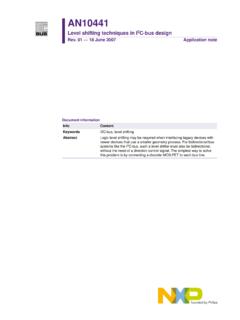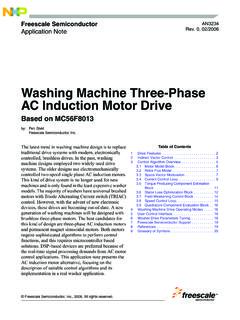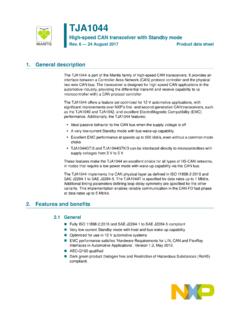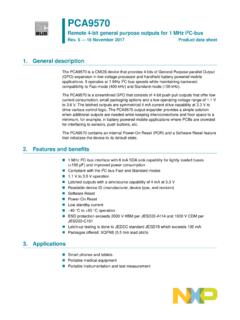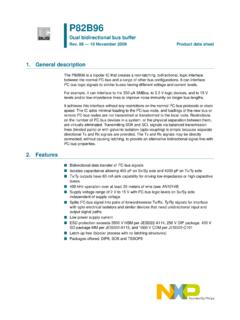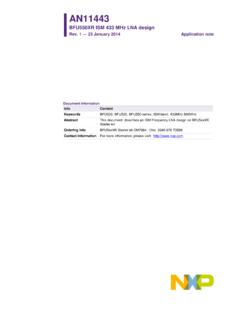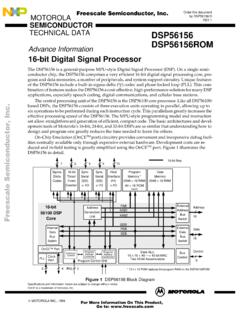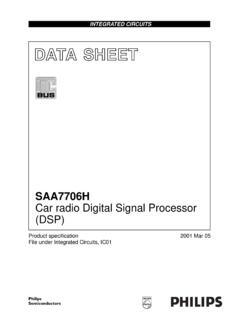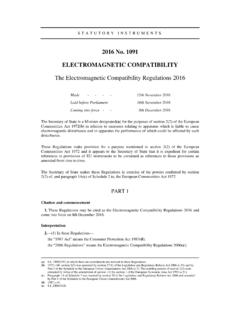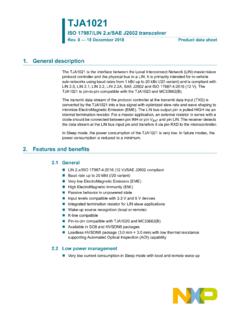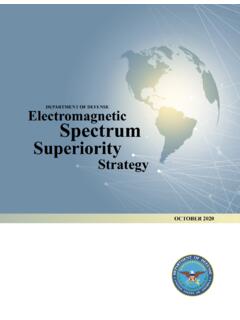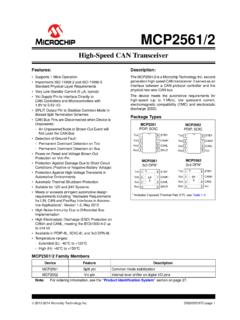Transcription of High-speed CAN transceiver - NXP
1 1. General descriptionThe TJA1051 is a High-speed CAN transceiver that provides an interface between a Controller Area Network (CAN) protocol controller and the physical two-wire CAN bus. The transceiver is designed for High-speed CAN applications in the automotive industry, providing differential transmit and receive capability to (a microcontroller with) a CAN protocol TJA1051 belongs to the third generation of High-speed CAN transceivers from NXP Semiconductors, offering significant improvements over first- and second-generation devices such as the TJA1050. It offers improved electromagnetic compatibility (EMC) and ElectroStatic Discharge (ESD) performance, and also features: Ideal passive behavior to the CAN bus when the supply voltage is off TJA1051T/3 and TJA1051TK/3 can be interfaced directly to microcontrollers with supply voltages from 3 Vto5 VThe TJA1051 implements the CAN physical layer as defined in ISO 11898-2:2016 and SAE J2284-1 to SAE J2284-5.
2 This implementation enables reliable communication in the CAN FD fast phase at data rates up to 5 features make the TJA1051 an excellent choice for all types of HS-CAN networks, in nodes that do not require a standby mode with wake-up capability via the Features and General ISO 11898-2:2016 and SAE J2284-1 to SAE J2284-5 compliant Timing guaranteed for data rates up to 5 Mbit/s in the CAN FD fast phase Suitable for 12 V and 24 V systems Low electromagnetic Emission (EME) and high electromagnetic Immunity (EMI) VIO input on TJA1051T/3 and TJA1051TK/3 allows for direct interfacing with 3 V to 5 V microcontrollers (available in SO8 and very small HVSON8 packages respectively) EN input on TJA1051T/E allows the microcontroller to switch the transceiver to a very low-current Off mode Available in SO8 package or leadless HVSON8 package ( mm mm) with improved Automated Optical Inspection (AOI) capability Dark green product (halogen free and Restriction of Hazardous Substances (RoHS) compliant) AEC-Q100 qualifiedTJA1051 High-speed CAN transceiverRev.
3 9 28 November 2017 Product data sheetTJA1051 All information provided in this document is subject to legal disclaimers. NXP 2017. All rights data sheetRev. 9 28 November 2017 2 of 25 NXP SemiconductorsTJA1051 High-speed CAN Low-power management Functional behavior predictable under all supply conditions transceiver disengages from the bus when not powered up (zero load) Protection High ElectroStatic Discharge (ESD) handling capability on the bus pins Bus pins protected against transients in automotive environments Transmit Data (TXD) dominant time-out function Undervoltage detection on pins VCC and VIO Thermally protected3. Quick reference data 4. Ordering information Table reference dataSymbolParameterConditionsMinTypMaxUn itVCCsupply voltage on pin (VCC)undervoltage detection voltage on pin (VIO)undervoltage detection voltage on pin currentSilent mode; bus mode; bus dominant205070mAIIO supply current on pin VION ormal/Silent moderecessive; VTXD=VIO-80250 Adominant; VTXD= 0 V-350500 AVESD electrostatic discharge voltageIEC 61000-4-2 at pins CANH and CANL 8- +8kVVCANH voltage on pin CANH 58-+58 VVCANL voltage on pin CANL 58-+58 VTvjvirtual junction temperature 40-+150 CTable informationType numberPackage NameDescriptionVersionTJA1051 TSO8plastic small outline package; 8 leads; body width mmSOT96-1 TJA1051 All information provided in this document is subject to legal disclaimers.
4 NXP 2017. All rights data sheetRev. 9 28 November 2017 3 of 25 NXP SemiconductorsTJA1051 High-speed CAN transceiver [1]TJA1051T/3 and TJA1051TK/3 with VIOpin; TJA1051T/E with EN Block diagram TJA1051T/3[1]SO8plastic small outline package; 8 leads; body width mmSOT96-1 TJA1051T/E[1]SO8plastic small outline package; 8 leads; body width mmSOT96-1 TJA1051TK/3[1]HVSON8plastic thermal enhanced very thin small outline package; no leads; 8 terminals; body 3 3 mmSOT782-1 Table information ..continuedType numberPackage NameDescriptionVersion(1) In a transceiver without a VIO pin, the VIO input is internally connected to VCC.(2) Only present in the TJA1051 diagramTEMPERATUREPROTECTIONTIME-OUTMODE CONTROLDRIVERTXD1VI/O(1)S8EN(2)5 RXD4 SLOPECONTROL ANDDRIVERVCCCANHCANL76532 GNDTJA1051015aaa036 VCCVIO(1)TJA1051 All information provided in this document is subject to legal disclaimers. NXP 2017. All rights data sheetRev. 9 28 November 2017 4 of 25 NXP SemiconductorsTJA1051 High-speed CAN transceiver6.
5 Pinning Pinning Pin description [1]HVSON8 package die supply ground is connected to both the GND pin and the exposed center pad. The GND pin must be soldered to board ground. For enhanced thermal and electrical performance, it is recommended that the exposed center pad also be soldered to board TJA1051T: SO8b. TJA1051T/E: SO8c. TJA1051T/3: SO8d. TJA1051TK/3: HVSON8 Fig configuration diagrams7;'6*1'&$1+9 'Q F DDD 7-$ 77;'6*1'&$1+9 '(1 DDD 7-$ 7 (7;'6*1'&$1+9 '9,2 DDD 7-$ 7 5;' 9 ' 9,2 &$1/ &$1+ 6 DDD 7-$ 7. WHUPLQDO LQGH[ DUHD7 UDQVSDUHQW WRS YLHZT able descriptionSymbolPinDescriptionTXD1trans mit data inputGND[1]2groundVCC3supply voltageRXD4receive data output; reads out data from the bus connected; in TJA1051T versionEN5enable control input; TJA1051T/E onlyVIO5supply voltage for I/O level adapter; TJA1051T/3 and TJA1051TK/3 onlyCANL6 LOW-level CAN bus lineCANH7 HIGH-level CAN bus lineS8 Silent mode control inputTJA1051 All information provided in this document is subject to legal disclaimers.))]
6 NXP 2017. All rights data sheetRev. 9 28 November 2017 5 of 25 NXP SemiconductorsTJA1051 High-speed CAN transceiver7. Functional descriptionThe TJA1051 is a High-speed CAN stand-alone transceiver with Silent mode. It combines the functionality of the TJA1050 transceiver with improved EMC and ESD handling capability. Improved slope control and high DC handling capability on the bus pins provides additional application TJA1051 is available in three versions, distinguished only by the function of pin 5: The TJA1051T is backwards compatible with the TJA1050 The TJA1051T/3 and TJA1051TK/3 allow for direct interfacing to microcontrollers with supply voltages down to 3 V The TJA1051T/E allows the transceiver to be switched to a very low-current Off Operating modesThe TJA1051 supports two operating modes, Normal and Silent, which are selected via pin S. An additional Off mode is supported in the TJA1051T/E via pin EN. See Ta b l e 4 for a description of the operating modes under normal supply conditions.
7 [1]Only available on the TJA1051T/E.[2]LOW if the CAN bus is dominant, HIGH if the CAN bus is recessive.[3] X = don t Normal modeA LOW level on pin S selects Normal mode. In this mode, the transceiver is able to transmit and receive data via the bus lines CANH and CANL (see Figure 1 for the block diagram). The differential receiver converts the analog data on the bus lines into digital data which is output to pin RXD. The slopes of the output signals on the bus lines are controlled internally and are optimized in a way that guarantees the lowest possible electromagnetic Emission (EME). Silent modeA HIGH level on pin S selects Silent mode. In Silent mode the transmitter is disabled, releasing the bus pins to recessive state. All other IC functions, including the receiver, continue to operate as in Normal mode. Silent mode can be used to prevent a faulty CAN controller from disrupting all network modesModeInputsOutputsPin EN[1]Pin SPin TXDCAN driverPin RXDN ormalHIGHLOWLOW dominantactive[2]HIGHLOWHIGH recessiveactive[2]SilentHIGHHIGHX[3]rece ssiveactive[2]Off[1]LOWX[3]X[3]floatingf loatingTJA1051 All information provided in this document is subject to legal disclaimers.
8 NXP 2017. All rights data sheetRev. 9 28 November 2017 6 of 25 NXP SemiconductorsTJA1051 High-speed CAN Off modeA LOW level on pin EN of TJA1051T/E selects Off mode. In Off mode the entire transceiver is disabled, allowing the microcontroller to save power when CAN communication is not required. The bus pins are floating in Off mode, making the transceiver invisible to the rest of the Fail-safe TXD dominant time-out functionA TXD dominant time-out timer is started when pin TXD is set LOW. If the LOW state on pin TXD persists for longer than tto(dom)TXD, the transmitter is disabled, releasing the bus lines to recessive state. This function prevents a hardware and/or software application failure from driving the bus lines to a permanent dominant state (blocking all network communications). The TXD dominant time-out timer is reset when pin TXD is set HIGH. The TXD dominant time-out time also defines the minimum possible bit rate of 20 kbit/s.
9 Internal biasing of TXD, S and EN input pinsPin TXD has an internal pull-up to VIO and pins S and EN (TJA1051T/E) have internal pull-downs to GND. This ensures a safe, defined state in case one or more of these pins is left Undervoltage detection on pins VCC and VIOS hould VCC or VIO drop below their respective undervoltage detection levels (Vuvd(VCC) and Vuvd (VIO); see Ta b l e 7), the transceiver will switch off and disengage from the bus (zero load) until VCC and VIO have Overtemperature protectionThe output drivers are protected against overtemperature conditions. If the virtual junction temperature exceeds the shutdown junction temperature, Tj(sd), the output drivers will be disabled until the virtual junction temperature falls below Tj(sd) and TXD becomes recessive again. Including the TXD condition ensures that output driver oscillations due to temperature drift are VIO supply pinThere are three versions of the TJA1051 available, only differing in the function of a single pin.
10 Pin 5 is either an enable control input (EN), a VIO supply pin or is not VIO on the TJA1051T/3 and TJA1051TK/3 should be connected to the microcontroller supply voltage (see Figure 6). This will adjust the signal levels of pins TXD, RXD and S to the I/O levels of the microcontroller. For versions of the TJA1051 without a VIO pin, the VIO input is internally connected to VCC. This sets the signal levels of pins TXD, RXD and S to levels compatible with 5 V information provided in this document is subject to legal disclaimers. NXP 2017. All rights data sheetRev. 9 28 November 2017 7 of 25 NXP SemiconductorsTJA1051 High-speed CAN transceiver8. Limiting values [1]The device can sustain voltages up to the specified values over the product lifetime, provided applied voltages (including transients) never exceed these values.[2]According to IEC TS 62228 (2007), Section ; parameters for standard pulses defined in ISO7637 part 2: 2004-06.[3]According to IEC TS 62228 (2007), Section ; DIN EN 61000-4-2.
